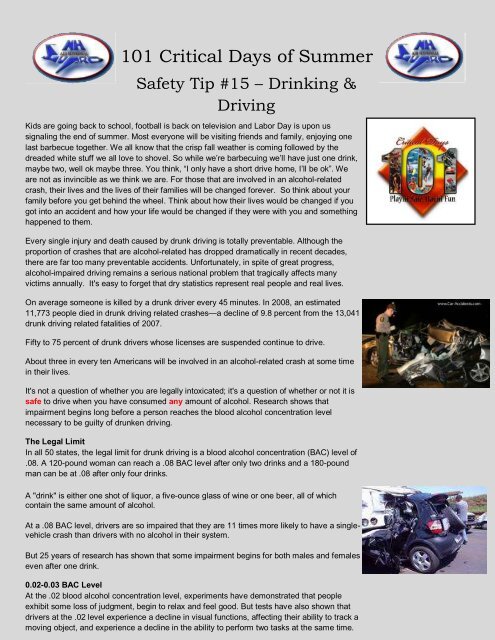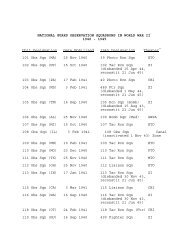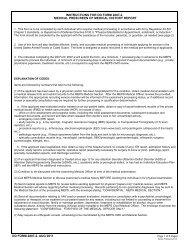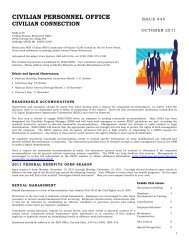Safety Tip 15 - Drinking and Driving
Safety Tip 15 - Drinking and Driving
Safety Tip 15 - Drinking and Driving
Create successful ePaper yourself
Turn your PDF publications into a flip-book with our unique Google optimized e-Paper software.
101 Critical Days of Summer<br />
<strong>Safety</strong> <strong>Tip</strong> #<strong>15</strong> – <strong>Drinking</strong> &<br />
<strong>Driving</strong><br />
Kids are going back to school, football is back on television <strong>and</strong> Labor Day is upon us<br />
signaling the end of summer. Most everyone will be visiting friends <strong>and</strong> family, enjoying one<br />
last barbecue together. We all know that the crisp fall weather is coming followed by the<br />
dreaded white stuff we all love to shovel. So while we’re barbecuing we’ll have just one drink,<br />
maybe two, well ok maybe three. You think, ―I only have a short drive home, I’ll be ok‖. We<br />
are not as invincible as we think we are. For those that are involved in an alcohol-related<br />
crash, their lives <strong>and</strong> the lives of their families will be changed forever. So think about your<br />
family before you get behind the wheel. Think about how their lives would be changed if you<br />
got into an accident <strong>and</strong> how your life would be changed if they were with you <strong>and</strong> something<br />
happened to them.<br />
Every single injury <strong>and</strong> death caused by drunk driving is totally preventable. Although the<br />
proportion of crashes that are alcohol-related has dropped dramatically in recent decades,<br />
there are far too many preventable accidents. Unfortunately, in spite of great progress,<br />
alcohol-impaired driving remains a serious national problem that tragically affects many<br />
victims annually. It's easy to forget that dry statistics represent real people <strong>and</strong> real lives.<br />
On average someone is killed by a drunk driver every 45 minutes. In 2008, an estimated<br />
11,773 people died in drunk driving related crashes—a decline of 9.8 percent from the 13,041<br />
drunk driving related fatalities of 2007.<br />
Fifty to 75 percent of drunk drivers whose licenses are suspended continue to drive.<br />
About three in every ten Americans will be involved in an alcohol-related crash at some time<br />
in their lives.<br />
It's not a question of whether you are legally intoxicated; it's a question of whether or not it is<br />
safe to drive when you have consumed any amount of alcohol. Research shows that<br />
impairment begins long before a person reaches the blood alcohol concentration level<br />
necessary to be guilty of drunken driving.<br />
The Legal Limit<br />
In all 50 states, the legal limit for drunk driving is a blood alcohol concentration (BAC) level of<br />
.08. A 120-pound woman can reach a .08 BAC level after only two drinks <strong>and</strong> a 180-pound<br />
man can be at .08 after only four drinks.<br />
A "drink" is either one shot of liquor, a five-ounce glass of wine or one beer, all of which<br />
contain the same amount of alcohol.<br />
At a .08 BAC level, drivers are so impaired that they are 11 times more likely to have a singlevehicle<br />
crash than drivers with no alcohol in their system.<br />
But 25 years of research has shown that some impairment begins for both males <strong>and</strong> females<br />
even after one drink.<br />
0.02-0.03 BAC Level<br />
At the .02 blood alcohol concentration level, experiments have demonstrated that people<br />
exhibit some loss of judgment, begin to relax <strong>and</strong> feel good. But tests have also shown that<br />
drivers at the .02 level experience a decline in visual functions, affecting their ability to track a<br />
moving object, <strong>and</strong> experience a decline in the ability to perform two tasks at the same time.
These changes may be very subtle <strong>and</strong> barely noticeable to the person who has had only one<br />
drink, but in an emergency situation while behind the wheel of a vehicle, they could cause the<br />
driver to react (or not react) as they would without having had a drink.<br />
0.04-0.06 BAC: Feeling of well-being, relaxation, lower inhibitions, sensation of warmth,<br />
euphoria. Some minor impairment of reasoning <strong>and</strong> memory, lowering of caution (a release of<br />
inhibition). Your behavior may become exaggerated <strong>and</strong> emotions intensified (Good emotions<br />
are better, bad emotions are worse). Some people experience loss of small-muscle control –<br />
such as being able to focus their eyes quickly.<br />
0.07-0.09 BAC: Slight impairment of balance, speech, vision, reaction time, <strong>and</strong> hearing.<br />
Euphoria. Judgment <strong>and</strong> self-control are reduced, <strong>and</strong> caution, reason <strong>and</strong> memory are<br />
impaired, .08 is legally impaired <strong>and</strong> it is illegal to drive at this level. You will probably believe<br />
that you are functioning better than you really are.<br />
0.10-0.125 BAC: Significant impairment of motor coordination <strong>and</strong> loss of good judgment.<br />
Speech may be slurred; balance, vision, reaction time <strong>and</strong> hearing will be impaired. Euphoria.<br />
0.13-0.<strong>15</strong> BAC: Gross motor impairment <strong>and</strong> lack of physical control. Blurred vision <strong>and</strong><br />
major loss of balance. Euphoria is reduced <strong>and</strong> dysphoria (anxiety, restlessness) is beginning<br />
to appear. Judgment <strong>and</strong> perception are severely impaired.<br />
0.16-0.19 BAC: Dysphoria predominates, nausea may appear. The drinker has the<br />
appearance of a "sloppy drunk."<br />
0.20 BAC: Felling dazed, confused or otherwise disoriented. May need help to st<strong>and</strong> or walk.<br />
If you injure yourself you may not feel the pain. Some people experience nausea <strong>and</strong><br />
vomiting at this level. The gag reflex is impaired <strong>and</strong> you can choke if you do vomit. Blackouts<br />
are likely at this level so you may not remember what has happened.<br />
0.25 BAC: All mental, physical <strong>and</strong> sensory functions are severely impaired. Increased risk of<br />
asphyxiation from choking on vomit <strong>and</strong> of seriously injuring yourself by falls or other<br />
accidents. http://bloodalcoholcalculator.org/<br />
0.30 BAC: STUPOR. You have little comprehension of where you are. You may pass out<br />
suddenly <strong>and</strong> be difficult to awaken.<br />
0.35 BAC: Coma is possible. This is the level of surgical anesthesia.<br />
0.40 BAC <strong>and</strong> up: Onset of coma, <strong>and</strong> possible death due to<br />
respiratory arrest.<br />
Play it smart during weekends <strong>and</strong> holidays (<strong>and</strong> every day). If you plan<br />
to party away from home – <strong>and</strong> this includes on the water – be sure to<br />
appoint a designated driver for the car or operator of the boat.<br />
Whatever you do, DON’T get behind the wheel<br />
if you’ve been drinking!<br />
Be safe this weekend <strong>and</strong> let’s close out<br />
the 101 Critical Days of Summer without<br />
any mishaps this weekend!!!<br />
Have a great Labor Day Weekend - Your<br />
Risk Management Staff!!!<br />
This document was derived<br />
from multiple sources. Sources<br />
are available upon request in<br />
the <strong>15</strong>7 ARW/SE Office.

















